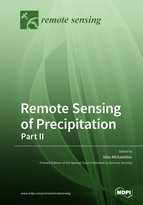Remote Sensing of Precipitation: Part II
A special issue of Remote Sensing (ISSN 2072-4292). This special issue belongs to the section "Atmospheric Remote Sensing".
Deadline for manuscript submissions: closed (30 September 2020) | Viewed by 89411
Special Issue Editor
Interests: meteorology; atmospheric remote sensing
Special Issues, Collections and Topics in MDPI journals
Special Issue Information
Dear Colleagues,
Precipitation is a well-recognized pillar in the global water and energy balances. The accurate and timely understanding of its characteristics at the global, regional and local scales is indispensable for a clearer insight on the mechanisms underlying the Earth’s atmosphere-ocean complex system. Precipitation is one of the elements that is documented to be greatly affected by climate change.
In its various forms, precipitation comprises the primary source of freshwater which is vital for the sustainability of almost all human activities. Its socio-economic significance is fundamental in managing this natural resource effectively in applications ranging from irrigation to industrial and household usage.
Remote sensing of precipitation is pursued through a broad spectrum of continuously enriched and upgraded instrumentation, embracing sensors which can be ground-based (e.g., weather radars), satellite-borne (e.g., passive or active space-borne sensors), underwater (e.g., hydrophones), aerial, or ship-borne.
This Special Issue will host papers on all aspects of remote sensing of precipitation, including applications which embrace the use of remote sensing techniques of precipitation in tackling issues such as precipitation estimations and retrievals along with their methodologies and corresponding error assessment, precipitation modelling including validation, instrument comparison and calibration, understanding of cloud microphysical properties, precipitation downscaling, precipitation droplet size distribution, assimilation of remotely sensed precipitation into numerical weather prediction models, measurement of precipitable water vapor, etc. Also, papers on new technological advances as well as campaigns and missions on precipitation remote sensing (e.g., TRMM, GPM) are welcome.
Dr. Silas Michaelides
Guest Editor
Manuscript Submission Information
Manuscripts should be submitted online at www.mdpi.com by registering and logging in to this website. Once you are registered, click here to go to the submission form. Manuscripts can be submitted until the deadline. All submissions that pass pre-check are peer-reviewed. Accepted papers will be published continuously in the journal (as soon as accepted) and will be listed together on the special issue website. Research articles, review articles as well as short communications are invited. For planned papers, a title and short abstract (about 100 words) can be sent to the Editorial Office for announcement on this website.
Submitted manuscripts should not have been published previously, nor be under consideration for publication elsewhere (except conference proceedings papers). All manuscripts are thoroughly refereed through a single-blind peer-review process. A guide for authors and other relevant information for submission of manuscripts is available on the Instructions for Authors page. Remote Sensing is an international peer-reviewed open access semimonthly journal published by MDPI.
Please visit the Instructions for Authors page before submitting a manuscript. The Article Processing Charge (APC) for publication in this open access journal is 2700 CHF (Swiss Francs). Submitted papers should be well formatted and use good English. Authors may use MDPI's English editing service prior to publication or during author revisions.
Keywords
- Precipitation
- Weather radar
- Quantitative Precipitation Estimation (QPE)
- Underwater precipitation remote sensing
- Cloud microphysical properties
- TRMM and GPM






